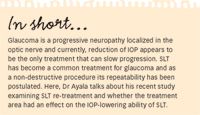Is selective laser trabeculoplasty repeatable?
In this article, Dr Ayala talks about his recent study examining SLT re-treatment and whether the treatment area had an effect on the IOP-lowering ability of SLT.

As SLT is a non-destructive procedure, repeatability has been postulated.1 We have demonstrated that SLT applied twice to the same region of the trabecular meshwork (TM) gave the same IOP reduction as treating a new area.2 These results indicate that SLT seems to be repeatable.
Treatment in the same place or not, no difference

Patients who were chosen to be re-treated with SLT (SLT 2) were asked to participate in the study. Patients included in the study were randomized to either SLT 2 in the same treated area (the lower part of the TM) or to SLT 2 in the adjacent upper part of the TM that was not previously treated. The IOP was measured before secondary laser treatment as well as 2 hours and 1, 3 and 6 months after treatment. The IOP was measured three times and an average value was calculated.
A total of 80 eyes (40 eyes in each group) from 80 patients were included in the study and all participants attended all of their appointments. The mean age was 75.25 ± 8.2 years, and the gender distribution was 41.25% men and 58.75% women. Fifty of the eyes suffered from pseudoexfoliation glaucoma and 30 eyes suffered from primary open-angle glaucoma.
One month after SLT 2, the average IOP had decreased from 22 mmHg to 17 mmHg (a reduction of 5 mmHg) in the group treated twice in the same area of the TM and from 23 to 18 mmHg (a reduction of 5 mmHg) in the group treated twice in two different areas of the TM.
There were no significant differences in IOP reduction seen between the two groups at 2 hours or at 1, 3, or 6 months after SLT 2 (ANOVA, p = 0.137). The average time interval between SLT 1 and SLT 2 was 12.9 months.
Conclusion
In conclusion, our results suggest that the IOP-lowering effect of SLT is not affected by the section of TM that was treated. These results are for laser treatments applied twice, and further investigations are needed to test the efficacy of SLT when more than two treatments are administered. The time in between the two exposures might also be considered as well as repair mechanisms occurring that can alter the response.
References
1. T. Realini, J. Glaucoma, 2008;17(6):497–502.
2. M. Ayala, Graefe's Arch. Clin. Exp. Ophthalmol., 2014;252(2):315–320.
